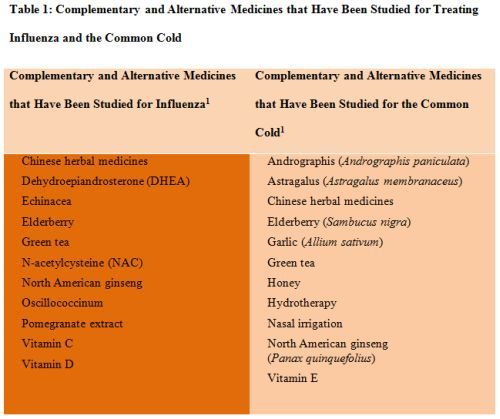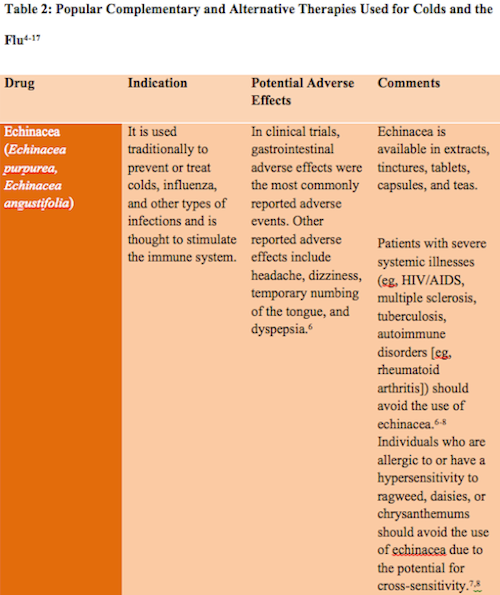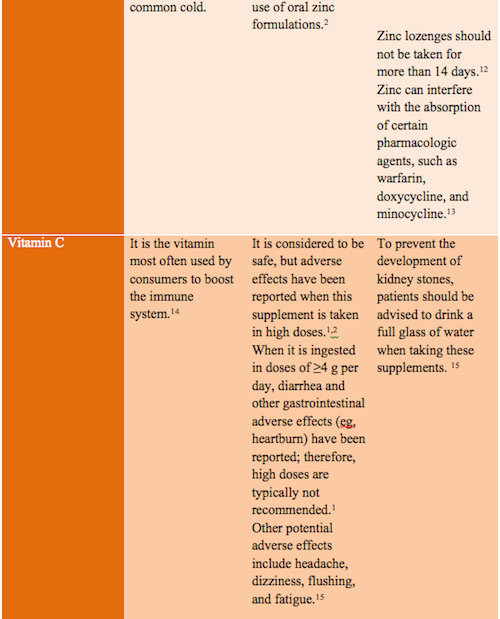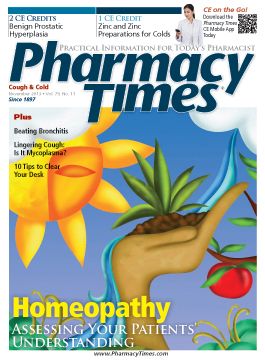Complementary and Alternative Therapies for Colds and Influenza
As the popularity of complementary and alternative supplements continues to escalate, consumers are increasingly likely to seek advice from their pharmacists.
As the popularity of complementary and alternative supplements continues to escalate, consumers are increasingly likely to seek advice from their pharmacists.
As the popularity of complementary and alternative supplements continues to escalate, some consumers elect to use these supplements in place of traditional medications to reduce the duration and severity of the symptoms associated with the common cold or the influenza virus.
Pharmacists are likely to encounter patient questions regarding the safety and efficacy of these products and therefore should be prepared to counsel patients on the proper use, adverse effects, and potential interactions associated with the use of these supplements. According to the National Institutes of Health National Center for Complementary and Alternative Medicine (NCCAM), the use of complementary and alternative medicine (CAM) therapies for the prevention and management of the common cold ranked eighth among adults and third among the pediatric patient population.1 CAM therapies for the flu were ranked among the 15 most common reasons for using CAM therapies among children, but not among the most common reasons in adults.1

According to NCCAM, there is no conclusive scientific evidence that any CAM therapies are useful in preventing the flu. NCCAM also reports that with regard to colds, some CAM therapies, such as zinc, may significantly decrease the duration or severity of the common cold.1 While some studies report some possible benefits, the overall findings regarding specific CAM therapies are limited and evidence is conflicting.1,2 Research is ongoing to explore the prospective use of CAM therapies in the prevention of the common cold as well as the ability of these therapies to diminish the incidence of colds and the severity and duration of symptoms linked with the common cold and the influenza virus (Online Table 1).1,2
Numerous complementary products are marketed for enhancement of the immune system as well as prevention and management of the symptoms most commonly associated with the common cold and the flu. The most popular therapies in this category include echinacea, high-dose vitamin C, and zinc lozenges.2 More in-depth information about these products can be found in Table 2. New products on the market include Cold-EEZE Oral Spray and Cold-EEZE Daytime/Nighttime Quick Melts (Cold-EEZE, Inc). Other new products are Heel Inc's Reboost product line, Hyland’s DEFEND Cold and Cough, Hyland’s DEFEND Severe Cold and Flu, and Hyland’s DEFEND Cold and Cough Night (Hyland’s Inc) as well as Zicam Cold Remedy Ultra Crystal and Zicam Naturals Cough Suppressants (Matrixx Initiatives, Inc) (Table 3).



Table 3: Examples of Complementary and Alternative Therapies for the Common Cold and Influenza
Brand Name
Manufacturer
Homeostasis Labs Cough & Cold Relief
Homeostasis Labs Cough & Cold Relief Children’s Formula
Homeostasis Flu Relief
Homeostasis Labs
Similasan 100% Natural Cold and Mucus Relief Liquid
Similasan Sore Throat Spray
Similasan Nasal Mist, Cold and Sinus
Similasan 100% Natural Cough Relief Liquid
Similasan Kids Cough & Fever Relief
Similasan Kids Cold & Mucus Relief
Similasan
Cold-EEZE Cold Remedy Lozenges
Cold-EEZE Cold Remedy Oral Spray
Cold-EEZE Daytime/Nighttime Quick Melts
Cold-EEZE
Boiron Children’s Coldcalm Pellets
Boiron Coldcalm
Boiron Children’s Chestal Cough Syrup
Boiron Chestal Cough Syrup
Boiron
Zicam Ultra Cold Remedy
Zicam Oral Mist
Zicam Cold Remedy Chewables
Zicam Ultra Crystals
Zicam Lozenges
Matrixx Initiatives, Inc
Halls Defense
Halls
Sambucol Cold and Flu
Sambucol Cold and Flu Night Time Syrup
Sambucol for Kids
Sambucol Original Tablets or Liquid Extract
Sambucol Immune Formula
PharmaCare
Hyland’s 4 Kids Cold ’n Cough Nighttime
Hyland’s Adult Cough Syrup
Hyland’s Bronchial Cough
Hyland’s Cold Tablets with Zinc
Hyland’s 4 Kids Cold ‘n Cough
Hyland’s Complete
Hyland’s 4 Kids Cough Syrup with 100% Natural Honey
Hyland’s Baby Cough Syrup
Hyland’s 4 Kids Sniffles ‘n Sneezes
Hyland’s 4 Kids Cold Relief with Zinc
Hyland’s Sore Throat
Hyland’s 4 Kids Complete Cold n Flu
Hyland’s Complete Flu Care
Hyland’s Flu
Hyland’s DEFEND Severe Cold and Flu
Hyland’s DEFEND Cold and Cough Night
Hyland’s
Puralin Decongestant Tablets
Apothecus Pharmaceutical Corp
Boericke & Tafel Cough & Bronchial Syrup
Boericke & Tafel
Homeolab USA Kids Relief Cough and Cold
Homeolab USA Flu Oral Solution
Homeolab USA Cough and Cold Nighttime Syrup
Homeolab USA
Nectadyn Homeopathic Cough Syrup/Expectorant
Heel Inc
Reboost Decongestion Spray with Natural Ingredients
Reboost Cold/Flu Relief tablets with Natural Ingredients
Reboost Cough Relief with Natural Ingredients
Reboost Throat Relief with Natural Ingredients
Heel Inc
A popular product marketed to reduce the duration and severity of flu symptoms such as headaches, body aches, chills, and fever is Oscillococcinum (Boiron). Oscillococcinum contains Anas barbariae hepatis et cordis extractum 200CK HPUS and is indicated for patients 2 years and older.3 It has no known drug interactions or adverse effects.3 Studies show that 62.9% of patients receiving this agent reported improvement or resolution of symptoms after 48 hours of administration.3 Another homeopathic flu product is Flu Relief (Homeostasis Labs), which contains CAM agents to manage fever, chills, body aches, and sneezing. In addition, several products are marketed and formulated to strengthen the immune system. Examples include Airborne tablets (Reckitt Benckiser), which include a combination of vitamins, minerals, amino acids, and herbs to support the immune system.2 The manufacturer suggests that consumers use these products before entering crowded environments such as airplanes or classrooms. Although these products are popular, their safety and efficacy have not been proved.2 These products are available as chewables, effervescent tablets, or single-dose packets that should be added to water.
Clinical Studies and the Most Commonly Used CAMs for Colds and Flu
Echinacea
Results from various studies have been conflicting and more investigation is needed. A study published in the December 2010 issue of the Annals of Internal Medicine evaluated the possible therapeutic effects of echinacea as a treatment for the common cold.4,5 The study concluded that echinacea had no effect on decreasing the severity or duration of the common cold.5 A 2007 meta-analysis of 14 controlled trials in adults concluded that Echinacea purpurea taken preventively decreased the risk of developing the common cold by as much as 58% and decreased the duration of a cold by 1.4 days, both of which were considered to be statistically significant.6 A 2012 study concluded that preventive intake of echinacea for 4 months may reduce the duration of the common cold.7
Zinc
The effect of zinc in reducing the severity and duration of common cold symptoms remains uncertain.10 However, a 2011 review published in the Cochrane Database of Systematic Reviews reported that zinc lozenges or zinc syrup did reduce the duration and severity of the common cold when taken within the first 24 hours of the onset of symptoms.10,11 Results from a meta-analysis published in the July 2011 issue of The Open Respiratory Medicine Journal reported that high-dose, not low-dose, zinc lozenges may shorten the duration of the common cold.12 The study reported that depending on the dosage and composition of zinc lozenges, the use of zinc lozenges may curtail the duration of a common cold by an estimated 40%.11 Results from a 2009 review report that doses of more than 70 mg per day have consistently diminished the duration of colds; however, additional research is needed to determine the optimal dosage and treatment guidelines.1 In another 2012 study, researchers concluded that zinc administered within 24 hours of the onset of symptoms may reduce the duration of a cold; however, preventive supplementation is not recommended due to lack of clinical data.13
Vitamin C
Results from a 2007 analysis of 30 clinical trials showed that taking vitamin C routinely (at least 0.2 g per day) did not decrease the likelihood of getting a cold.1 However, the use of vitamin C was associated with a slight reduction in the severity of cold symptoms and the duration of the common cold.1 A review published in 2009 that researched the effects of vitamins and minerals for colds concluded that supplementation with vitamin C does have some potential benefits in treating the common cold; however, because only a few therapeutic trials have been performed, more research is needed to ascertain effective dosages and treatment guidelines.1 No studies have included the pediatric population.1 Results of a 2012 study showed that the combination of vitamin C and zinc may be efficacious in improving symptoms of the common cold.18
Final Thoughts
Although CAM therapies are often perceived as natural and safe, many also have the potential to interact with other medications or cause adverse effects. Prior to use, patients, especially those with preexisting medical conditions (eg, pregnant or lactating women, patients taking any other pharmacologic agent, pediatric and geriatric patients), should be advised to discuss with their primary health care provider the use of CAM therapies marketed for the prevention and management of the common cold. Health care experts would concur that the paramount defense against the influenza virus is obtaining an annual flu vaccination, and health care professionals should encourage patients to get vaccinated yearly.
As more consumers explore the various CAM therapies on the market, a growing number of studies are evaluating the safety and efficacy of CAM products; however, more information is needed. For more information on CAM products for cold and flu viruses, please visit the NCCAM website at http://nccam.nih.gov.
Ms. Terrie is a clinical pharmacy writer based in Haymarket, Virginia.
References
- The flu, the common cold, and complementary health approaches. National Institutes of Health National Center for Complementary and Alternative Medicine website. http://nccam.nih.gov/health/flu/ataglance.htm. Accessed October 2, 2013.
- Scolaro K. Disorders related to colds and allergy. In: Krinsky D, Berardi R, Ferreri S, et al, eds. Handbook of Nonprescription Drugs. 17th ed. Washington, DC: American Pharmacists Association; 2011.
- Healthcare professional oscillococcinum product information Boiron website. www.oscillo.com/medical. Accessed October 5, 2013.
- Echinacea. National Institutes of Health National Center for Complementary and Alternative Medicine website. http://nccam.nih.gov/health/echinacea/ataglance.htm. Accessed October 2, 2013.
- Barrett B, Brown R, Rakel D, et al. Echinacea for treating the common cold. Ann Intern Med. 2010;153:769-777.
- Shah SA, Sander S, White CM, Rinaldi M, Coleman CI. Evaluation of echinacea for the prevention and treatment of the common cold: a meta-analysis [abstract]. Lancet Infect Dis. 2007;7:473-480.
- McQueen C, Orr K. Natural products. In: Krinsky D, Berardi R, Ferreri S, et al, eds. Handbook of Nonprescription Drugs. 17th ed. Washington, DC: American Pharmacists Association; 2011.
- Echinacea drug facts. Drugs.com website. www.drugs.com/npp/echinacea.html. Accessed October 6, 2013.
- Echinacea drug information. Medscape drug reference. http://reference.medscape.com/drug/black-sampson-black-susans-echinacea-344472#5. Accessed October 5, 2013.
- Zinc information. National Institutes of Health National Center for Complementary and Alternative Medicine website. http://nccam.nih.gov/health/zinc. Accessed October 2, 2013.
- Singh M, Das RR. Zinc for the common cold. Cochrane Database of Systematic Reviews. http://www.ncbi.nlm.nih.gov/pubmed/21328251. Accessed November 8, 2013.
- Barclay L. High dose zinc lozenges may reduce duration of cold symptoms. Medscape website. www.medscape.com/viewarticle/747426. Accessed October 2, 2013.
- Science M, Johnstone J, Roth DE, Guyatt G, Loeb M. Zinc for the treatment of the common cold: a systematic review and meta-analysis of randomized controlled trials. CMAJ. 2012;184(10):E551-E561.
- Zinc. Merck Manual for Health Care Professionals online edition. www.merckmanuals.com/professional/special_subjects/dietary_supplements/zinc.html. Accessed October 2, 2013.
- Cold-EEZE product information. www.coldeeze.com/faq/#nul. Accessed October 2, 2013.
- Kemper K, et al. Complementary and alternative medicine therapies for cold and flu season: what is the science? Medscape website. www.medscape.com/viewarticle/711485_3. Accessed October 2, 2013.
- Ascorbic acid drug information. Medscape drug information. http://reference.medscape.com/drug/cenolate-vitamin-c-ascorbic-acid-344416#91. Accessed October 2, 2013.
- Maggini S, Beveridge S, Suter M. A combination of high dose vitamin C plus zinc for the common cold. J Int Med Res. 2012;40(1):28-42.

